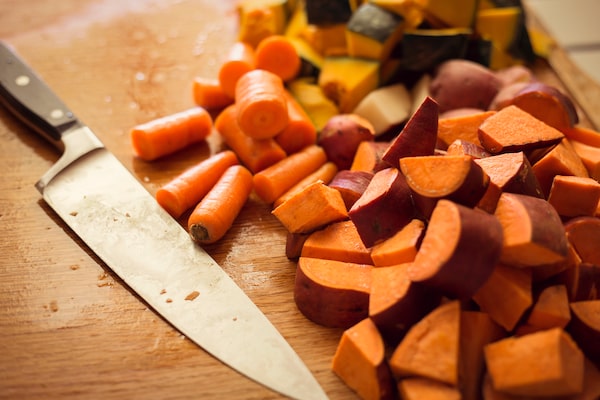
You’ll find beta-carotene in sweet potato, carrots, butternut squash, spinach, Swiss chard, broccoli, red pepper, mango, cantaloupe and dried apricots.iStockPhoto / Getty Images
The Question
Are there foods that can help with joint paint?
Are there certain foods that can help reduce osteoarthritis pain? What about supplements?
The Answer
Dietary tweaks – like increasing fibre and Vitamin K – may help lesson symptoms
Osteoarthritis is the most common form of arthritis, affecting one in six Canadians. It’s estimated that one-quarter of people with the disease are unable to perform everyday activities.
Osteoarthritis is progressive and can’t be cured. Treatments, including medication and lifestyle measures, are aimed at relieving symptoms and improving mobility.
While there’s no specific diet to treat the disease, certain dietary modifications may help cut inflammation and support joint health.
Osteoarthritis occurs when the cartilage in a joint breaks down and the underlying bone changes. Symptoms include joint pain, stiffness, swelling, reduced flexibility and a creaking sound when joints move. The knees, hips, hands, big toe and spine are most commonly affected.
Risk factors include aging, family history, previous joint injury, sedentary lifestyle and obesity. Carrying excess weight increases the strain on weight-bearing joints; excess body fat can also cause inflammation, worsening symptoms.
Research suggests that the following dietary strategies may help lessen symptoms as well as disease progression.
6. Weight control
There’s plenty of evidence that losing excess weight, even 5 per cent of body weight, leads to pain relief and improved joint function in knee osteoarthritis. And the greater the weight loss, the greater the benefit.
Include regular exercise tailored to your mobility in your weight-loss program. Research indicates that a combination of strength, flexibility and aerobic exercise is most likely to improve joint pain and function.
5. Add anti-inflammatory fats
Dietary fat may influence cartilage breakdown and inflammation. A recent study of 2,092 participants with knee osteoarthritis, for example, found that higher intakes of saturated fat, found in fatty meats and dairy products, were linked to increased disease progression.
Higher intakes of monounsaturated fats, which have anti-inflammatory properties, were associated with reduced progression. Good sources of monounsaturated fats include olive oil, olives, avocado, peanuts, peanut oil, almonds, cashews, pecans and pistachios.
Omega-3 fatty acids in oily fish (e.g., salmon, trout, sardines, mackerel and herring) may also help reduce inflammation. Aim to include two servings in your diet each week.
There’s some evidence, albeit limited, that a daily, low-dose fish oil supplement (1,000 milligrams) may improve joint pain in knee osteoarthritis.
4. Consume dietary fibre
Two large long-term studies from the United States published in 2017 found that a fibre-rich diet protected against painful knee osteoarthritis.
Participants who consumed the most fibre reported less knee pain and were less likely to be diagnosed with knee osteoarthritis. Those who ate more fibre also reported less worsening of joint pain over four years.
A high-fibre diet can help lower inflammation by fuelling the growth of healthy gut bacteria. It may also aid weight loss.
Include fruits, vegetables and whole grains in your diet each day. Make a point of eating pulses (e.g., black beans, chickpeas and lentils) on a regular basis.
3. Add antioxidant-rich foods
Beta-carotene and vitamins C and E act as antioxidants protecting the body from damaging free radicals, which may be involved in osteoarthritis progression. Vitamin C is also needed for collagen formation.
While supplement studies have turned up conflicting results, it’s still important to get enough of these nutrients from your diet.
You’ll find beta-carotene in sweet potato, carrots, butternut squash, spinach, Swiss chard, broccoli, red pepper, mango, cantaloupe and dried apricots.
Citrus fruit, kiwifruit, strawberries, mango, cantaloupe, red and green bell peppers, broccoli, cauliflower, Brussels sprouts, cabbage and tomato juice are good sources of vitamin C.
Sunflower seeds, sunflower oil, safflower oil, almonds, hazelnuts, peanuts and peanut butter are high in vitamin E.
2. Eat food high in vitamin K
Observational research has linked higher intakes of vitamin K, needed to maintain healthy bone and cartilage, to a lower risk of knee osteoarthritis and lower levels of inflammation.
Cooked leafy greens (e.g., kale, spinach, Swiss chard, collards, beet greens) are exceptional sources of vitamin K.
1. Try supplements
Most studies have shown that glucosamine sulfate modestly reduces pain in knee osteoarthritis, while the evidence for chondroitin sulfate is mixed.
Small studies also suggest that curcumin, the active ingredient in the spice turmeric, can improve arthritic knee pain. Speak to your health care provider about supplementing safely.
Leslie Beck, a Toronto-based private practice dietitian, is Director of Food and Nutrition at Medcan.
Sign up for the weekly Health & Wellness newsletter for the latest news and advice.